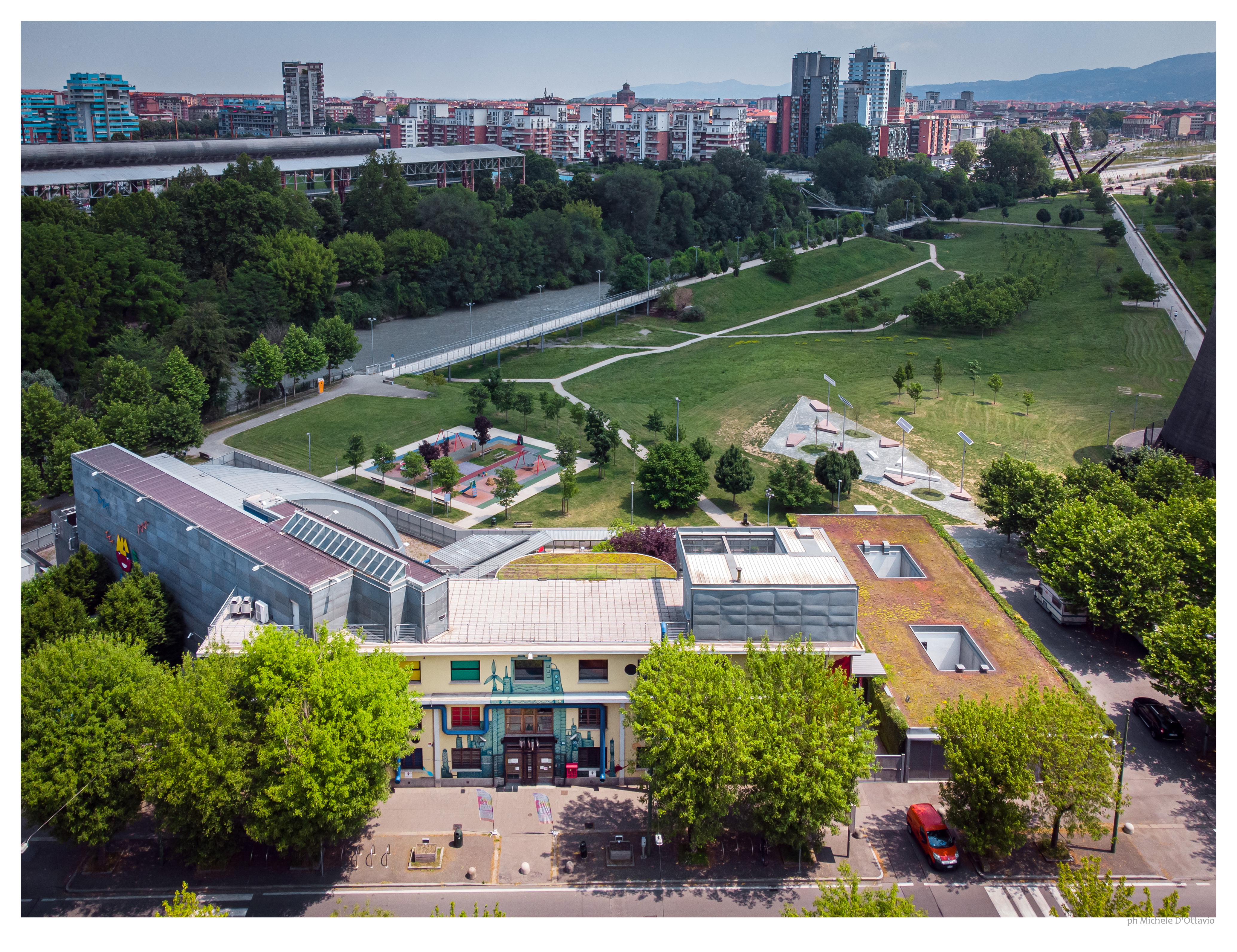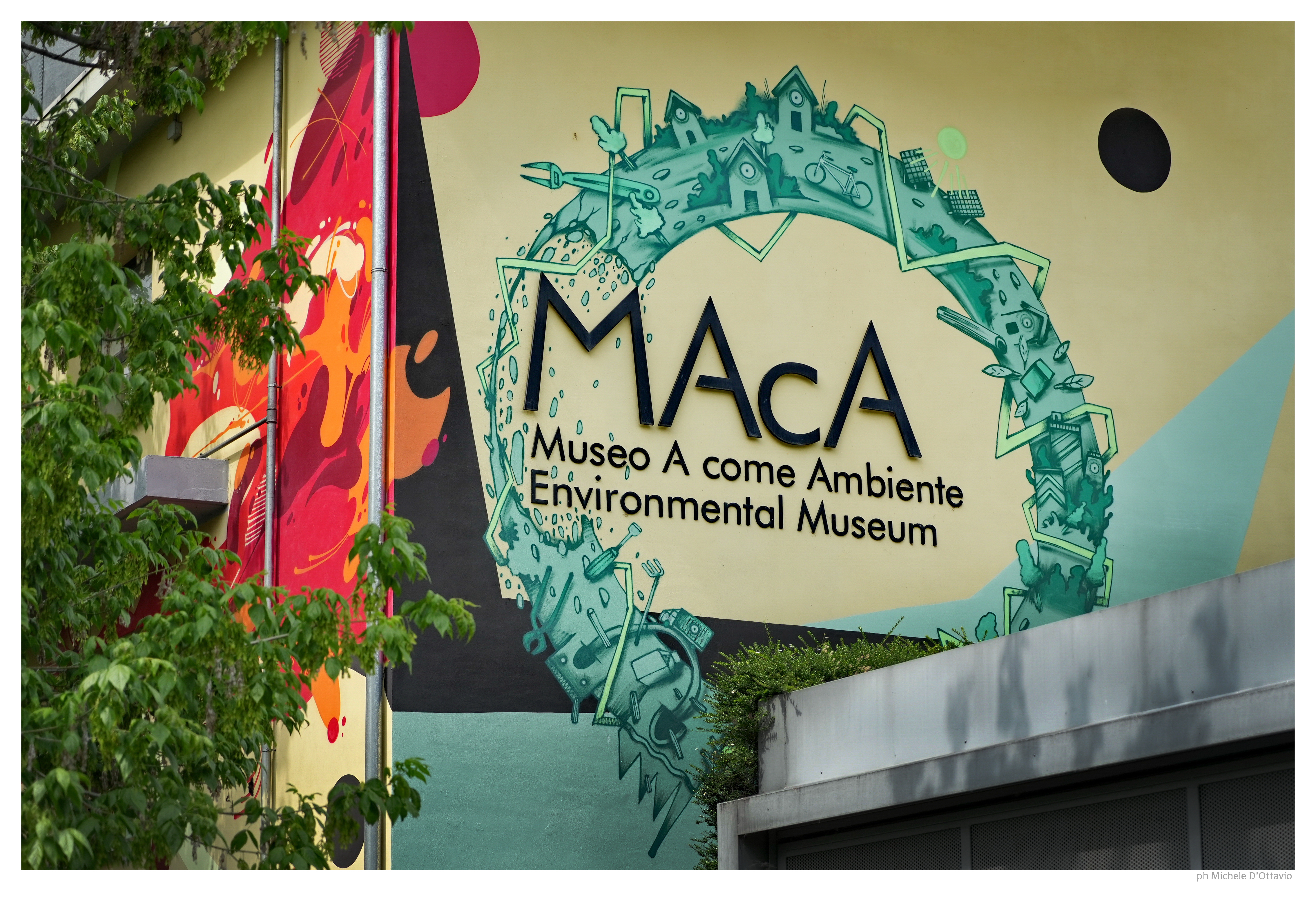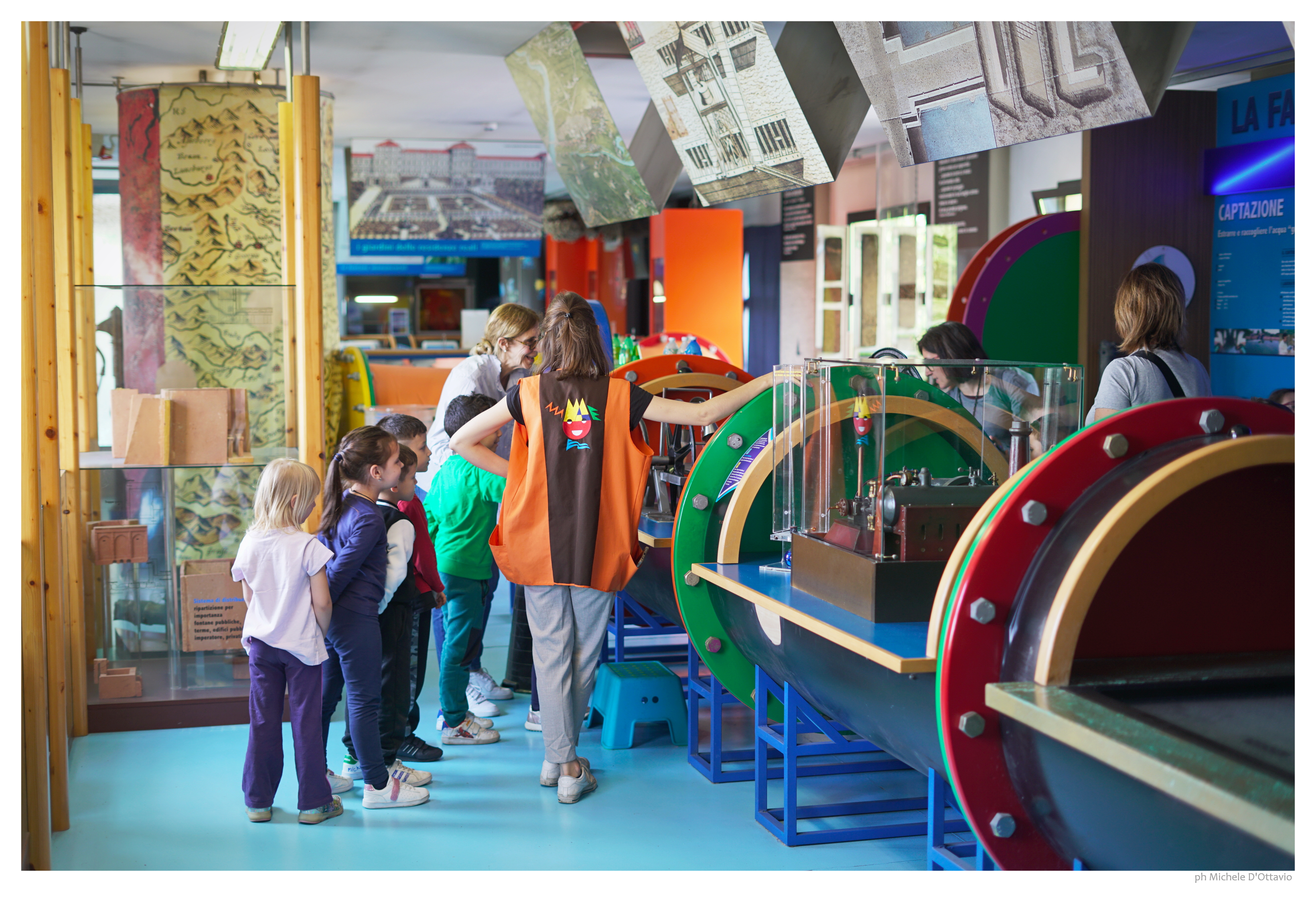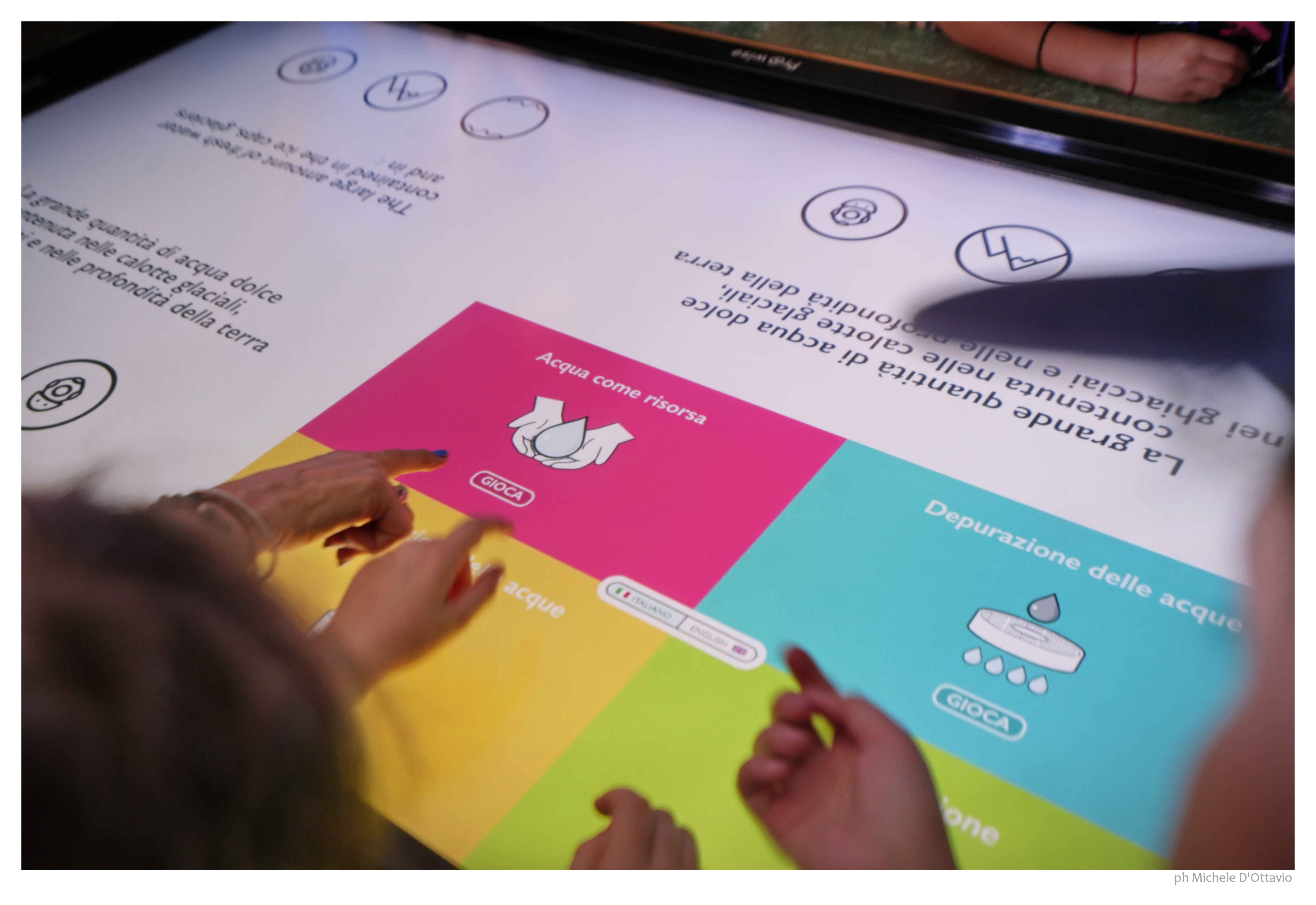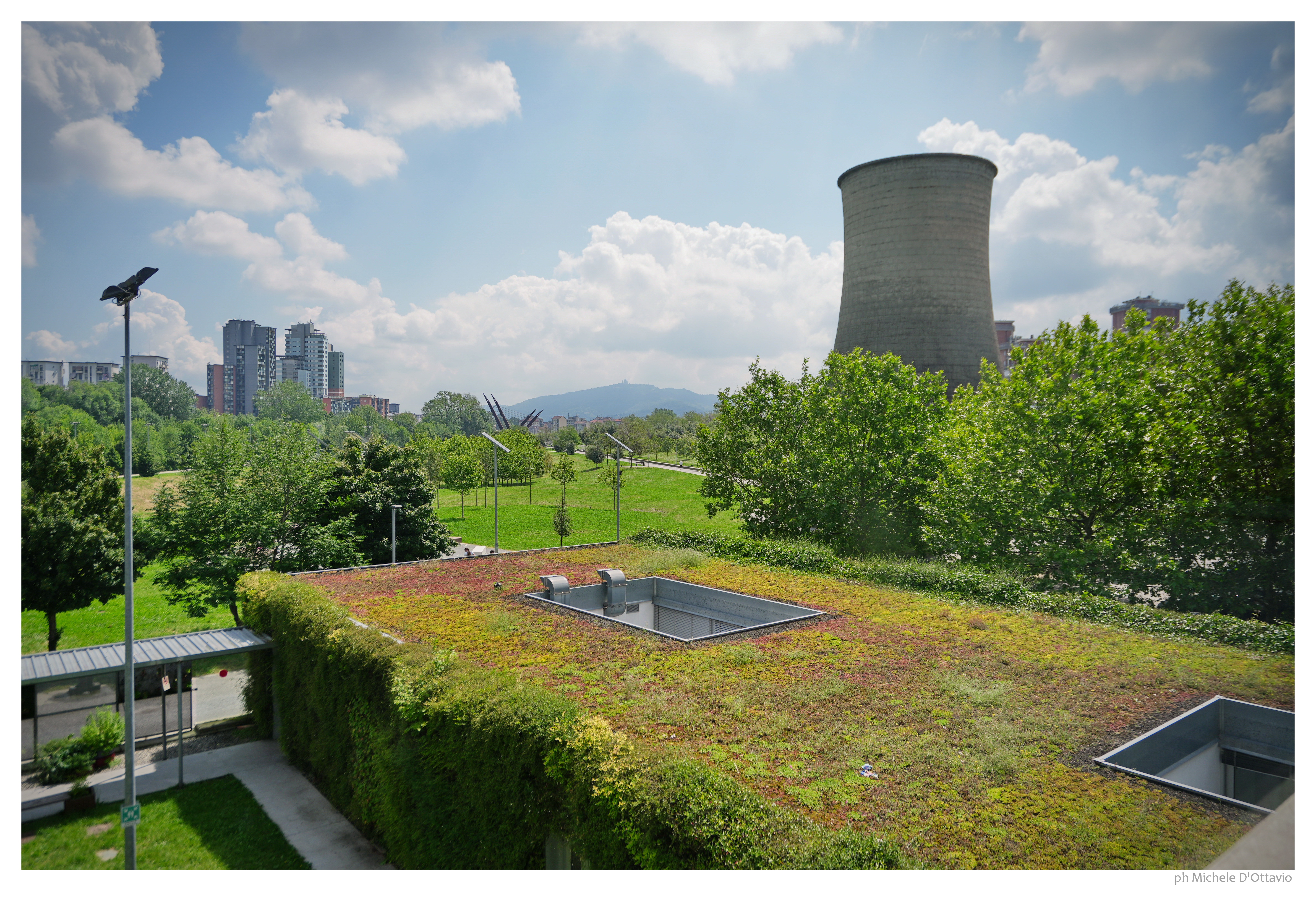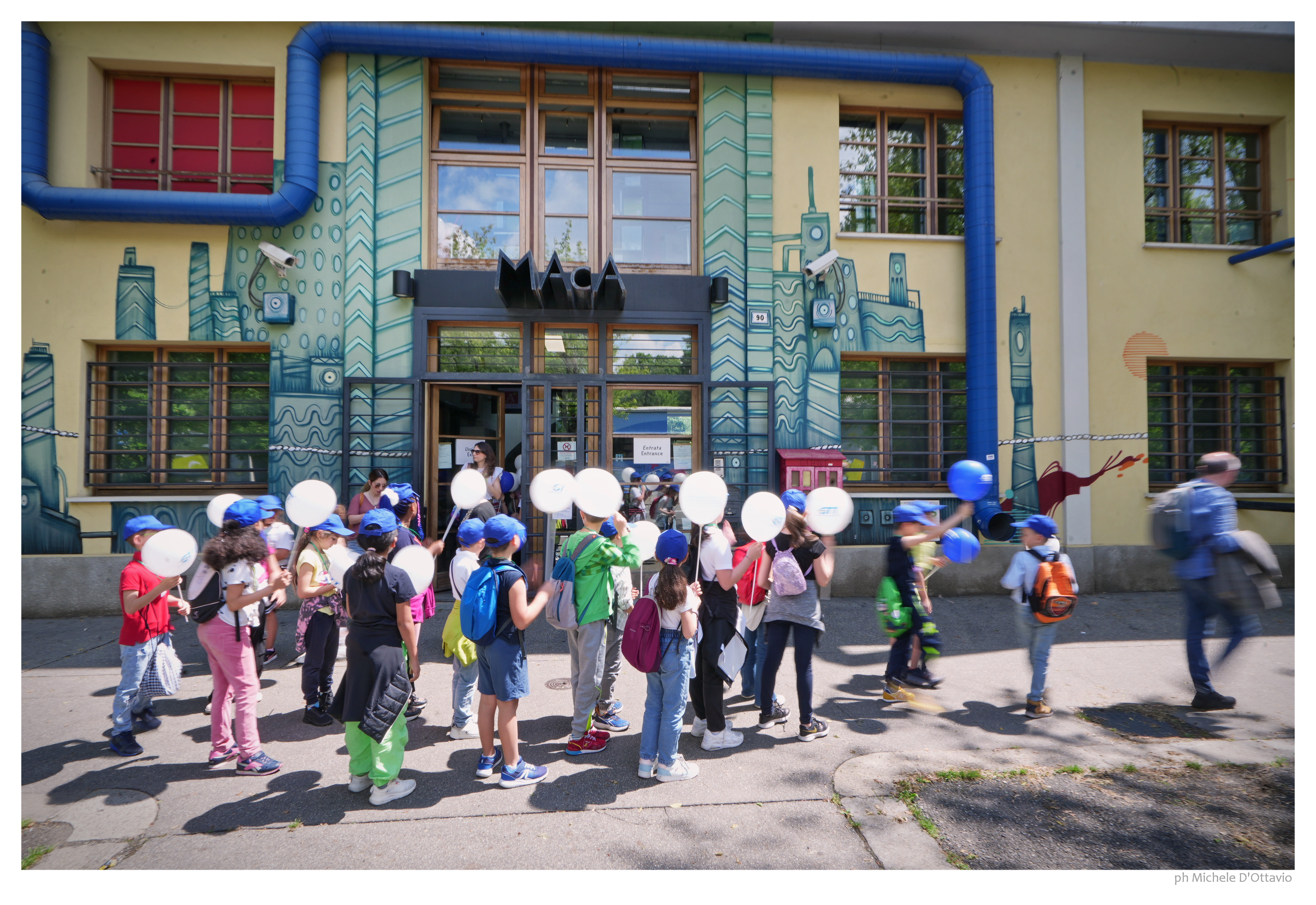Reconnecting with nature
MAcA Museo A come Ambiente Torino
A come Ambiente Museum: From Industrial Site to Environmental Education Hub
“A come Ambiente Museum” plays a key role in linking the urban landscape with nature through educational initiatives. Its engaging exhibitions and interactive experiences promote environmental awareness for generations to come. Housed in a transformed industrial building within Parco Dora, a former industrial district turned green space in 2006, the museum exemplifies the shift from industrial heritage to an environmental education hub, inspiring action for a sustainable future.
Italy
Local
Turin
Mainly urban
It refers to other types of transformations (soft investment)
Yes
2024-12-31
No
No
No
As a representative of an organisation, in partnership with other organisations
The MAcA is a hub dedicated to exploring human-environment interactions and promoting sustainability. It’s managed by the “A come Ambiente” association made up of public entities and private companies that share values related to promoting scientific culture and environmental awareness. First museum born in Europe in 2003 entirely focused on environmental issues, MAcA has been offering creative spaces, exhibitions, interactive labs, and educational trails for over 20 years with the aim to encourage experimentation, discovery, and engagement. The museum's educational activities are primarily targeted at young generations, with trails designed for schools.
Located within Parco Dora, a vast green area in the city of Torino (456.000sq), the museum integrates natural environments with remnants of the area's industrial past. The park, crossed by the Dora Riparia River, is an important post-industrial site that the City has courageously decided to reconvert into urban green space. The museum itself occupies the historic Palazzina 37, once a Michelin firehouse.
Since its restoration in 2004, the building has become the MAcA Museum headquarters. Spanning over 4.300 sq, the museum includes three pavilions: the restored Historic Building 37, the Guscio Pavilion, and the Verde Pavilion, plus an internal garden featuring urban vertical gardens.
MAcA's educational programmes focus on key environmental themes such as energy, waste, water, food, and transportation. It offers over 40 hands-on workshops and scientific labs, engaging visitors in environmental science. In 2024, the museum attracted more than 34.400 visitors, with over 26.400 of them being school groups.
MAcA engages the community with educational activities, exhibitions on biodiversity, climate change, and sustainability, and hands-on workshops on vertical gardening and composting. These initiatives align with the recent City’s Climate City Contract, fostering a stronger connection to sustainable practices.
Located within Parco Dora, a vast green area in the city of Torino (456.000sq), the museum integrates natural environments with remnants of the area's industrial past. The park, crossed by the Dora Riparia River, is an important post-industrial site that the City has courageously decided to reconvert into urban green space. The museum itself occupies the historic Palazzina 37, once a Michelin firehouse.
Since its restoration in 2004, the building has become the MAcA Museum headquarters. Spanning over 4.300 sq, the museum includes three pavilions: the restored Historic Building 37, the Guscio Pavilion, and the Verde Pavilion, plus an internal garden featuring urban vertical gardens.
MAcA's educational programmes focus on key environmental themes such as energy, waste, water, food, and transportation. It offers over 40 hands-on workshops and scientific labs, engaging visitors in environmental science. In 2024, the museum attracted more than 34.400 visitors, with over 26.400 of them being school groups.
MAcA engages the community with educational activities, exhibitions on biodiversity, climate change, and sustainability, and hands-on workshops on vertical gardening and composting. These initiatives align with the recent City’s Climate City Contract, fostering a stronger connection to sustainable practices.
Sustainability
Education
Heritage
Innovation
Community
The museum has integrated sustainability into every aspect of its operations, from the design of exhibits to the selection of materials and the energy-efficient infrastructure. By focusing on key environmental challenges, MAcA empowers visitors of all ages and backgrounds to understand the importance of preserving natural resources and ecosystems for future generations.
MAcA directly addresses the value of biodiversity by showcasing ecosystems and endangered species, as well as providing practical solutions for protecting habitats.
The museum’s commitment to natural resource management is reflected in its advocacy for responsible consumption and waste reduction. MAcA plays a vital role in educating visitors on the global impact of climate change and offering actionable strategies for reducing carbon footprints. MAcA’s electric and thermal energy consumptions are in fact compensated annually thanks to Asja CO2-project, focuses on reducing carbon emissions through CO2 capture, renewable energy, and sustainability initiatives. Every two years MAcA is awarded an Eco-sustainability Certificate that certifies, through the CO₂ reduction system, the compensation of the estimated greenhouse gas emission of the Museum. In the last two years considered, -540 Ton CO2 has been compensated.
MAcA exemplifies sustainability by promoting a holistic approach that connects the local community with global environmental movements. It not only raises awareness but also actively encourages sustainable behavior through workshops on recycling, sustainable agriculture, and energy conservation. In this regard, it is worth mentioning MAcA’s collaboration with Eduiren, the educational division of IREN’s group, sharing its scientific labs with the local community (one example: Tutti…SuperTerra” project).
Its initiatives make it an exemplary model for museums and cultural institutions, showcasing how education and culture can align with the urgent goals of sustainability and climate action.
MAcA directly addresses the value of biodiversity by showcasing ecosystems and endangered species, as well as providing practical solutions for protecting habitats.
The museum’s commitment to natural resource management is reflected in its advocacy for responsible consumption and waste reduction. MAcA plays a vital role in educating visitors on the global impact of climate change and offering actionable strategies for reducing carbon footprints. MAcA’s electric and thermal energy consumptions are in fact compensated annually thanks to Asja CO2-project, focuses on reducing carbon emissions through CO2 capture, renewable energy, and sustainability initiatives. Every two years MAcA is awarded an Eco-sustainability Certificate that certifies, through the CO₂ reduction system, the compensation of the estimated greenhouse gas emission of the Museum. In the last two years considered, -540 Ton CO2 has been compensated.
MAcA exemplifies sustainability by promoting a holistic approach that connects the local community with global environmental movements. It not only raises awareness but also actively encourages sustainable behavior through workshops on recycling, sustainable agriculture, and energy conservation. In this regard, it is worth mentioning MAcA’s collaboration with Eduiren, the educational division of IREN’s group, sharing its scientific labs with the local community (one example: Tutti…SuperTerra” project).
Its initiatives make it an exemplary model for museums and cultural institutions, showcasing how education and culture can align with the urgent goals of sustainability and climate action.
The MAcA Museum offers a unique approach to environmental issues through design and art. The Museum harmonises aesthetics with functionality, ensuring that beauty and purpose coexist in sustainable design. It consists of three buildings: the Historical Building, the Green Pavilion, and the Shell.
The Historical Building, formerly the headquarters of Michelin's fire prevention division, features 3 floors dedicated to energy, waste and water. The Green Pavilion, designed by Carlo Ratti Associati, spans 300 sq and focuses on nutrition, knowledge transfer and transport. Its green-covered walls, interrupted by patios, allow natural light and ventilation. The Shell, designed by Agostino Magnaghi architect, is a 250 sq open space for projections, conferences, temporary exhibitions, and labs.
Each exhibition uses interactive installations, eco-conscious materials, and visually striking elements to engage visitors. Art installations are not just decorative; they communicate the urgency of environmental protection, fostering emotional connections with the themes of sustainability, biodiversity, and climate change. The museum's design integrates artistic expression with these topics, ensuring the content is accessible and engaging to all. Inside the Museum, are installations by contemporary artists (e.g. Gilardi, Perotti, Mainolfi) and photographic works by Lucas, Lanzardo, d’Ottavio. The Museum's communication and mascot designs are by Paolo Mottura. The blue pipe installation on the facade was created by Interaction Design Lab and UrbanArt, while Ugo Nespolo designed the symbol on the facade.
MAcA has been part of an Urban Street Art project with “Il Cerchio E le Gocce” Association, creating murals that reflect the museum’s themes on its outdoor walls.
MAcA exemplifies how design and art can promote sustainable practices while offering a meaningful, immersive experience.
The Historical Building, formerly the headquarters of Michelin's fire prevention division, features 3 floors dedicated to energy, waste and water. The Green Pavilion, designed by Carlo Ratti Associati, spans 300 sq and focuses on nutrition, knowledge transfer and transport. Its green-covered walls, interrupted by patios, allow natural light and ventilation. The Shell, designed by Agostino Magnaghi architect, is a 250 sq open space for projections, conferences, temporary exhibitions, and labs.
Each exhibition uses interactive installations, eco-conscious materials, and visually striking elements to engage visitors. Art installations are not just decorative; they communicate the urgency of environmental protection, fostering emotional connections with the themes of sustainability, biodiversity, and climate change. The museum's design integrates artistic expression with these topics, ensuring the content is accessible and engaging to all. Inside the Museum, are installations by contemporary artists (e.g. Gilardi, Perotti, Mainolfi) and photographic works by Lucas, Lanzardo, d’Ottavio. The Museum's communication and mascot designs are by Paolo Mottura. The blue pipe installation on the facade was created by Interaction Design Lab and UrbanArt, while Ugo Nespolo designed the symbol on the facade.
MAcA has been part of an Urban Street Art project with “Il Cerchio E le Gocce” Association, creating murals that reflect the museum’s themes on its outdoor walls.
MAcA exemplifies how design and art can promote sustainable practices while offering a meaningful, immersive experience.
MAcA is committed to inclusion, ensuring accessibility for all by promoting affordability, accessibility, and inclusive design both in its programming and space.
MAcA fosters inclusivity through a wide range of educational activities specifically designed to be accessible to individuals with varying learning needs: the museum incorporates tactile exhibits, visual aids, and digital accessibility tools (Social Stories and the platform “Teaching and learning tools”) to ensure full participation. MAcA benefits from collaborations with the Paiedia Association, an organization focused on social inclusion for people with disabilities, and private foundations such as the CRT Foundation to enhance accessibility and inclusivity.
The museum also prioritizes affordability, offering low-cost or free admission to ensure that everyone, regardless of economic background, can benefit from its educational resources. Some examples: the collaboration with the City of Torino with “Crescere in Città” catalogue allows reduced entrance for visits and labs; access for people with physical or cognitive disabilities is actually free. Additionally, the Museum hosts community-focused programs, inviting local residents to participate in environmental initiatives and discussions, fostering a culture of collaboration and shared learning.
MAcA exemplifies inclusive governance by involving the community in the decision-making process. The museum regularly seeks input from local groups and individuals, ensuring that its programs reflect the needs and interests of its diverse audience using for example satisfaction surveys. This participatory approach helps shape a more inclusive and responsive museum experience.
MAcA serves as a model for how cultural institutions can promote inclusivity. Its holistic approach to engagement and its commitment to inclusivity make the museum a powerful example of how design, governance, and programming can work together.
MAcA fosters inclusivity through a wide range of educational activities specifically designed to be accessible to individuals with varying learning needs: the museum incorporates tactile exhibits, visual aids, and digital accessibility tools (Social Stories and the platform “Teaching and learning tools”) to ensure full participation. MAcA benefits from collaborations with the Paiedia Association, an organization focused on social inclusion for people with disabilities, and private foundations such as the CRT Foundation to enhance accessibility and inclusivity.
The museum also prioritizes affordability, offering low-cost or free admission to ensure that everyone, regardless of economic background, can benefit from its educational resources. Some examples: the collaboration with the City of Torino with “Crescere in Città” catalogue allows reduced entrance for visits and labs; access for people with physical or cognitive disabilities is actually free. Additionally, the Museum hosts community-focused programs, inviting local residents to participate in environmental initiatives and discussions, fostering a culture of collaboration and shared learning.
MAcA exemplifies inclusive governance by involving the community in the decision-making process. The museum regularly seeks input from local groups and individuals, ensuring that its programs reflect the needs and interests of its diverse audience using for example satisfaction surveys. This participatory approach helps shape a more inclusive and responsive museum experience.
MAcA serves as a model for how cultural institutions can promote inclusivity. Its holistic approach to engagement and its commitment to inclusivity make the museum a powerful example of how design, governance, and programming can work together.
The Museum (MAcA) has made active citizen and civil society engagement a central part of its mission, involving the local community in its environmental initiatives. The museum’s approach emphasizes participatory decision-making, collaboration, and education, ensuring that citizens are active contributors to the project’s success.
Community involvement begins with the museum’s programming. Workshops, interactive exhibits, and events are developed in consultation with local groups, schools, and environmental organizations. Teachers and students are constantly given satisfaction surveys at the end of their visit; local schools regularly participate in sustainability workshops and environmental art projects, contributing directly to exhibitions or citizen science projects that monitor local biodiversity. One example is the final temporary exhibition realized by classes in the LIFE prepAIR project, hosted at MAcA Museum.
The museum also works alongside community groups: collaborative initiatives such as clean-up campaigns (with Legambiente), sustainable gardening projects, and public discussions on climate action engage citizens in actions that positively impact the local environment. Notable examples include citizen science labs, such as aerial mapping techniques and biodiversity analysis in Dora Park.
The museum serves as a platform for these groups to share knowledge, voice concerns, and develop collective solutions, fostering a strong sense of community ownership.
This involvement has had a profound impact, allowing citizens to engage with environmental challenges, fostering a deeper connection with the local population. It has empowered individuals, created a more informed and motivated community.
By fostering collaboration, MAcA has become a living example of how public engagement drives meaningful environmental change, empowering communities and reinforcing the importance of collective action.
Community involvement begins with the museum’s programming. Workshops, interactive exhibits, and events are developed in consultation with local groups, schools, and environmental organizations. Teachers and students are constantly given satisfaction surveys at the end of their visit; local schools regularly participate in sustainability workshops and environmental art projects, contributing directly to exhibitions or citizen science projects that monitor local biodiversity. One example is the final temporary exhibition realized by classes in the LIFE prepAIR project, hosted at MAcA Museum.
The museum also works alongside community groups: collaborative initiatives such as clean-up campaigns (with Legambiente), sustainable gardening projects, and public discussions on climate action engage citizens in actions that positively impact the local environment. Notable examples include citizen science labs, such as aerial mapping techniques and biodiversity analysis in Dora Park.
The museum serves as a platform for these groups to share knowledge, voice concerns, and develop collective solutions, fostering a strong sense of community ownership.
This involvement has had a profound impact, allowing citizens to engage with environmental challenges, fostering a deeper connection with the local population. It has empowered individuals, created a more informed and motivated community.
By fostering collaboration, MAcA has become a living example of how public engagement drives meaningful environmental change, empowering communities and reinforcing the importance of collective action.
The A come Ambiente Association is a non-profit organisation, made up of public entities and companies committed to promoting scientific culture and environmental awareness.
MAcA is supported by the City: its activities are aligned with the city's current strategy, which aims to strengthen hubs that embody the NEB principles as outlined in the Torino's NEB Manifesto or during NEB’s lighthouse project DESIRE and in alignment with the recently signed Climate City Contract (Oct. 24).
As for partnership with other local initiatives, it has to be mentioned the long-term collaboration with CinemAmbiente for the annual realisation of CinemAmbiente Junior, national competition which aims to raise young people’s awareness on environmental sustainability through the elaboration of a short film.
MAcA also partners with Lavazza Museum, Museum of Saving, and PAV with the purpose of creating a network of museums sharing the same interest towards circular economy and sustainability and promoting fruitions of some labs at a reduced price.
Moreover, it is part of the Associazione Abbonamento Musei, offering free access to Abbonamento Musei Card holders: this helps local and regional citizen involvement.
MAcA has participated in several European research projects, including LIFE Climate Value Chains with Environment Park, which created the "PER FARE UN ALBERO" lab on forest sustainability; DEMOSOFC with the Polytechnic of Turin, focusing on energy production from fossil fuels vs. biogas; and LIFE prepAIR with the Piedmont Region and Arpa Piemonte, which developed a lab on air pollution and its impact on health and the environment.
The Museum is part of ECSITE (European Network of Science Centres and Museums), promoting science education, innovation, and public engagement across Europe.
These collaborations have contributed to MAcA's success, enriching its educational programmes and enhancing its role in promoting environmental sustainability through active public engagement.
MAcA is supported by the City: its activities are aligned with the city's current strategy, which aims to strengthen hubs that embody the NEB principles as outlined in the Torino's NEB Manifesto or during NEB’s lighthouse project DESIRE and in alignment with the recently signed Climate City Contract (Oct. 24).
As for partnership with other local initiatives, it has to be mentioned the long-term collaboration with CinemAmbiente for the annual realisation of CinemAmbiente Junior, national competition which aims to raise young people’s awareness on environmental sustainability through the elaboration of a short film.
MAcA also partners with Lavazza Museum, Museum of Saving, and PAV with the purpose of creating a network of museums sharing the same interest towards circular economy and sustainability and promoting fruitions of some labs at a reduced price.
Moreover, it is part of the Associazione Abbonamento Musei, offering free access to Abbonamento Musei Card holders: this helps local and regional citizen involvement.
MAcA has participated in several European research projects, including LIFE Climate Value Chains with Environment Park, which created the "PER FARE UN ALBERO" lab on forest sustainability; DEMOSOFC with the Polytechnic of Turin, focusing on energy production from fossil fuels vs. biogas; and LIFE prepAIR with the Piedmont Region and Arpa Piemonte, which developed a lab on air pollution and its impact on health and the environment.
The Museum is part of ECSITE (European Network of Science Centres and Museums), promoting science education, innovation, and public engagement across Europe.
These collaborations have contributed to MAcA's success, enriching its educational programmes and enhancing its role in promoting environmental sustainability through active public engagement.
MAcA Museum embraces an interdisciplinary approach to environmental education, integrating environmental protection, citizen engagement, sustainable development, social inclusion, technological innovation, and repurposing industrial heritage aligning with the New European Bauhaus (NEB) principles.
MAcA’s design and activities prioritize sustainability, addressing biodiversity, climate change, and pollution issues. Through interactive exhibits and educational programs, the museum engages local communities, schools, and organizations to raise awareness and empower citizens to tackle sustainability challenges. Only in 2024, nearly 700 visits and more than 600 labs have been realised.
The museum focuses on participation, offering workshops on vertical gardening, composting, and air pollution. These initiatives foster collaboration and social inclusion. More than 40 labs are organised each year during the weekend.
Technological innovation is central to MAcA's work, with eco-friendly design and multimedia installations addressing environmental issues. The museum’s energy-efficient building techniques and green architecture in the Green Pavilion highlight this commitment.
MAcA occupies a former industrial building in Parco Dora, a transformed industrial district now a green space. The museum’s design exemplifies repurposing industrial heritage, blending modern architecture with environmental principles to create a cultural space for sustainability. This renovation aligns with the NEB’s vision of transforming built heritage into spaces for sustainable living, social inclusion, and innovation.
The collaboration of diverse fields, architecture, education, technology, and environmental science, enhances the museum’s impact. This interdisciplinary approach ensures MAcA’s projects are both practical and inspiring, fostering a deep connection between the local community and environmental sustainability. MAcA is a model for sustainable and inclusive cultural spaces.
MAcA’s design and activities prioritize sustainability, addressing biodiversity, climate change, and pollution issues. Through interactive exhibits and educational programs, the museum engages local communities, schools, and organizations to raise awareness and empower citizens to tackle sustainability challenges. Only in 2024, nearly 700 visits and more than 600 labs have been realised.
The museum focuses on participation, offering workshops on vertical gardening, composting, and air pollution. These initiatives foster collaboration and social inclusion. More than 40 labs are organised each year during the weekend.
Technological innovation is central to MAcA's work, with eco-friendly design and multimedia installations addressing environmental issues. The museum’s energy-efficient building techniques and green architecture in the Green Pavilion highlight this commitment.
MAcA occupies a former industrial building in Parco Dora, a transformed industrial district now a green space. The museum’s design exemplifies repurposing industrial heritage, blending modern architecture with environmental principles to create a cultural space for sustainability. This renovation aligns with the NEB’s vision of transforming built heritage into spaces for sustainable living, social inclusion, and innovation.
The collaboration of diverse fields, architecture, education, technology, and environmental science, enhances the museum’s impact. This interdisciplinary approach ensures MAcA’s projects are both practical and inspiring, fostering a deep connection between the local community and environmental sustainability. MAcA is a model for sustainable and inclusive cultural spaces.
The Museum, founded in 2004, is a pioneer in its field and has consistently adapted to new technologies in its educational offerings.
It stands out for its innovative approach to addressing environmental issues through design and art, offering visitors a unique and impactful experience. Each exhibition is carefully designed to captivate and engage, with striking visual elements, interactive installations, and eco-conscious materials that create an immersive environment. In the realm of landscape bionomics, an augmented reality Sandbox serves as a powerful tool for teaching geological concepts, environmental science, and spatial awareness. Augmented reality is also integrated into the permanent Water exhibition, and through the SMAT Virtual Experience, visitors wear virtual visors to enjoy a fully immersive experience, revolutionising sensory perception and the educational journey.
The Museum is divided into four areas dedicated to Water, Waste, Energy, and Nutrition, offering over 40 scientific and creative labs. All visits, labs, and online activities follow a hands-on approach, encouraging analysis of phenomena, dialogue, games, and experiments for all ages.
MAcA Museum is a key reference, especially for the local community, in environmental education and citizen science. Parco Dora, which hosts the museum, is one of the city’s main parks covering 420,000 sqm and an example of the successful transformation of a post-industrial site, just like the Museum itself. The park now serves as an open-air museum through The Iron Valley project, a cultural space showcasing Turin’s industrial heritage. It uses both physical and virtual materials, including several totems. The virtual setup at Iron Valley features digital content owned by the city, with local residents contributing memories via themed exhibitions, photo galleries, videos, and georeferenced maps, aiming to engage and deepen their understanding of the local area.
It stands out for its innovative approach to addressing environmental issues through design and art, offering visitors a unique and impactful experience. Each exhibition is carefully designed to captivate and engage, with striking visual elements, interactive installations, and eco-conscious materials that create an immersive environment. In the realm of landscape bionomics, an augmented reality Sandbox serves as a powerful tool for teaching geological concepts, environmental science, and spatial awareness. Augmented reality is also integrated into the permanent Water exhibition, and through the SMAT Virtual Experience, visitors wear virtual visors to enjoy a fully immersive experience, revolutionising sensory perception and the educational journey.
The Museum is divided into four areas dedicated to Water, Waste, Energy, and Nutrition, offering over 40 scientific and creative labs. All visits, labs, and online activities follow a hands-on approach, encouraging analysis of phenomena, dialogue, games, and experiments for all ages.
MAcA Museum is a key reference, especially for the local community, in environmental education and citizen science. Parco Dora, which hosts the museum, is one of the city’s main parks covering 420,000 sqm and an example of the successful transformation of a post-industrial site, just like the Museum itself. The park now serves as an open-air museum through The Iron Valley project, a cultural space showcasing Turin’s industrial heritage. It uses both physical and virtual materials, including several totems. The virtual setup at Iron Valley features digital content owned by the city, with local residents contributing memories via themed exhibitions, photo galleries, videos, and georeferenced maps, aiming to engage and deepen their understanding of the local area.
MAcA's educational offer includes guided tours and over 48 laboratory activities on sustainability topics (water, energy, waste, food, transport, 360° environment), designed for various age groups from kindergarten to secondary school. The activities are aligned with the Environmental Education Guidelines set by the Ministry of Education, University and Research (MIUR) and the Ministry of the Environment and Protection of Land and Sea (MATTM), lasting 90 minutes each and catering to schools at all levels.
The Museum adopts an innovative approach to environmental education through design and art, with engaging exhibitions that encourage reflection on the human-nature relationship. As already mentioned, MAcA is divided into four main areas: Water, Waste, Energy, and Nutrition, where visitors interact with exhibits guided by scientific animators. Over 40 scientific and creative labs complement this offer, serving both school groups and families.
MAcA has expanded its reach by introducing remote guided tours and 45-minute distance labs, enabling geographically distant groups to participate and increasing the Museum's catchment area. The “MAcA goes to school” initiative brings activities directly to classes that cannot visit the Museum, supported by PILOTs, the Museum’s scientific animators.
Through the “A come A distanza” project, an online platform allows students and teachers to connect with environmental issues, conduct experiments, and take virtual tours. This platform brings the Museum’s educational activities to schools far from its location, using the same hands-on approach as on-site activities. The methodology also includes awareness-raising and training activities directly aimed at citizens, held in the park areas surrounding the Museum. This approach seeks to foster a connection between the Museum and the urban context, expanding the range of beneficiaries involved.
The Museum adopts an innovative approach to environmental education through design and art, with engaging exhibitions that encourage reflection on the human-nature relationship. As already mentioned, MAcA is divided into four main areas: Water, Waste, Energy, and Nutrition, where visitors interact with exhibits guided by scientific animators. Over 40 scientific and creative labs complement this offer, serving both school groups and families.
MAcA has expanded its reach by introducing remote guided tours and 45-minute distance labs, enabling geographically distant groups to participate and increasing the Museum's catchment area. The “MAcA goes to school” initiative brings activities directly to classes that cannot visit the Museum, supported by PILOTs, the Museum’s scientific animators.
Through the “A come A distanza” project, an online platform allows students and teachers to connect with environmental issues, conduct experiments, and take virtual tours. This platform brings the Museum’s educational activities to schools far from its location, using the same hands-on approach as on-site activities. The methodology also includes awareness-raising and training activities directly aimed at citizens, held in the park areas surrounding the Museum. This approach seeks to foster a connection between the Museum and the urban context, expanding the range of beneficiaries involved.
The methodology approach model is easily replicable due to its robust funding structure and the well-established dynamic between the Museum, students, and visitors, which is common throughout Europe. This shared foundation is key to the successful replication of both the methodologies and the results. The core element to be transferred to potential replicators is the innovative approach adopted by the Museum in recent years, characterised by interdisciplinarity and stakeholder involvement.
In addition to the methodology, there are numerous initiatives and activities that can be shared and replicated in different national and international contexts. For instance, MAcA Museum relies on a network of skilled scientific animators, or PILOTs, who are continuously trained in the latest science learning methodologies. To ensure accessibility and inclusion, PILOTs also attend specialised courses that enable people with different disabilities to enjoy the museum’s offerings.
Another example of MAcA’s replicable activities is the more than 40 scientific and creative labs, each supported by detailed protocols, making them easily transferable to other settings, such as schools, festivals, and external events.
Furthermore, several external organisations focused on environmental sustainability, climate change, and reconnection with nature have sought MAcA’s support in implementing hands-on methodologies. For example, the Green Learning project involved MAcA Museum in creating scientific labs for schools in Sicilian municipalities. Additionally, MAcA has provided team-building activities for international companies, such as IVECO S.p.A., a global leader in vehicle manufacturing, to raise employee awareness on key environmental challenges.
This broad applicability of MAcA’s methodology and activities ensures that the approach can be replicated and adapted in diverse contexts and for various groups of beneficiaries.
In addition to the methodology, there are numerous initiatives and activities that can be shared and replicated in different national and international contexts. For instance, MAcA Museum relies on a network of skilled scientific animators, or PILOTs, who are continuously trained in the latest science learning methodologies. To ensure accessibility and inclusion, PILOTs also attend specialised courses that enable people with different disabilities to enjoy the museum’s offerings.
Another example of MAcA’s replicable activities is the more than 40 scientific and creative labs, each supported by detailed protocols, making them easily transferable to other settings, such as schools, festivals, and external events.
Furthermore, several external organisations focused on environmental sustainability, climate change, and reconnection with nature have sought MAcA’s support in implementing hands-on methodologies. For example, the Green Learning project involved MAcA Museum in creating scientific labs for schools in Sicilian municipalities. Additionally, MAcA has provided team-building activities for international companies, such as IVECO S.p.A., a global leader in vehicle manufacturing, to raise employee awareness on key environmental challenges.
This broad applicability of MAcA’s methodology and activities ensures that the approach can be replicated and adapted in diverse contexts and for various groups of beneficiaries.
The “A come Ambiente” Museum contributes to the implementation of the 17 Sustainable Development Goals (SDGs). In particular to Goal 4 “Ensure inclusive and equitable quality education and promote lifelong learning opportunities for all” – target 4.7 “By 2030, ensure that all learners acquire the knowledge and skills needed to promote sustainable development, including, among others, through education for sustainable development and sustainable lifestyles, human rights, gender equality, promotion of a culture of peace and non-violence, global citizenship and appreciation of cultural diversity and of culture’s contribution to sustainable development”. Through its temporary and permanent exhibitions MAcA Museum aims to increase people's awareness on sustainability and the importance of environmental education. Goal 11 “Make cities and human settlements inclusive, safe, resilient and sustainable”, promoting the creation of a sustainable society from an environmental and social point of view, and the role of the Citizen Scientist. Goal 13 “Take urgent action to combat climate change and its impacts” – target 13.3 “Improve education, awareness-raising and human and institutional capacity on climate change mitigation, adaptation, impact reduction and early warning” promoting, through its educational activities, sustainable management of natural resources and awareness on climate change.
In 2024, MAcA Museum welcomed almost 34.500 visitors, including over 2.000 students from diverse educational levels, from nursery schools to universities. Most visitors came from Torino, nearby cities, and the Piedmont region, with increasing participation from schools in central and southern Italy, as well as France. Families and individual visitors accounted for 24% of the total, with an uptick in visits during school holidays.
MAcA's primary audience consists of school groups engaging with its permanent exhibition areas and scientific labs, making up 76% of visitors. The Museum has introduced free access for disabled individuals since 2024, enhancing social inclusion and equal opportunities. The focus on school groups ensures long-term sustainability by educating future generations, fostering environmental awareness, and encouraging responsible behaviours.
In 2024, over 8.000 family visitors explored the Museum, participating in free guided tours and scientific and creative labs, including "MAcA Kids" for 3-5-year-olds. The online "A come A distanza" initiative reached students from schools unable to attend in person. Additionally, over 700 participants engaged in outdoor activities, such as school labs and festival events.
As reported by the Observatorio Culturale del Piemonte, MAcA experienced a notable increase in attendance (61.4%), growing from 21.681 visits in 2022 to 35.002 in 2023.
This surge underscores the success of MAcA’s educational offerings, strategic partnerships, and effective communication efforts in expanding its reach and engaging a broader audience.
MAcA's initiatives have created a lasting positive impact on the local community and beyond. Its inclusive educational programs, including support for economically disadvantaged schools and people with disabilities, have broadened accessibility. These efforts, combined with hands-on learning, have contributed to greater environmental awareness and sustainable behaviours.
MAcA's primary audience consists of school groups engaging with its permanent exhibition areas and scientific labs, making up 76% of visitors. The Museum has introduced free access for disabled individuals since 2024, enhancing social inclusion and equal opportunities. The focus on school groups ensures long-term sustainability by educating future generations, fostering environmental awareness, and encouraging responsible behaviours.
In 2024, over 8.000 family visitors explored the Museum, participating in free guided tours and scientific and creative labs, including "MAcA Kids" for 3-5-year-olds. The online "A come A distanza" initiative reached students from schools unable to attend in person. Additionally, over 700 participants engaged in outdoor activities, such as school labs and festival events.
As reported by the Observatorio Culturale del Piemonte, MAcA experienced a notable increase in attendance (61.4%), growing from 21.681 visits in 2022 to 35.002 in 2023.
This surge underscores the success of MAcA’s educational offerings, strategic partnerships, and effective communication efforts in expanding its reach and engaging a broader audience.
MAcA's initiatives have created a lasting positive impact on the local community and beyond. Its inclusive educational programs, including support for economically disadvantaged schools and people with disabilities, have broadened accessibility. These efforts, combined with hands-on learning, have contributed to greater environmental awareness and sustainable behaviours.

